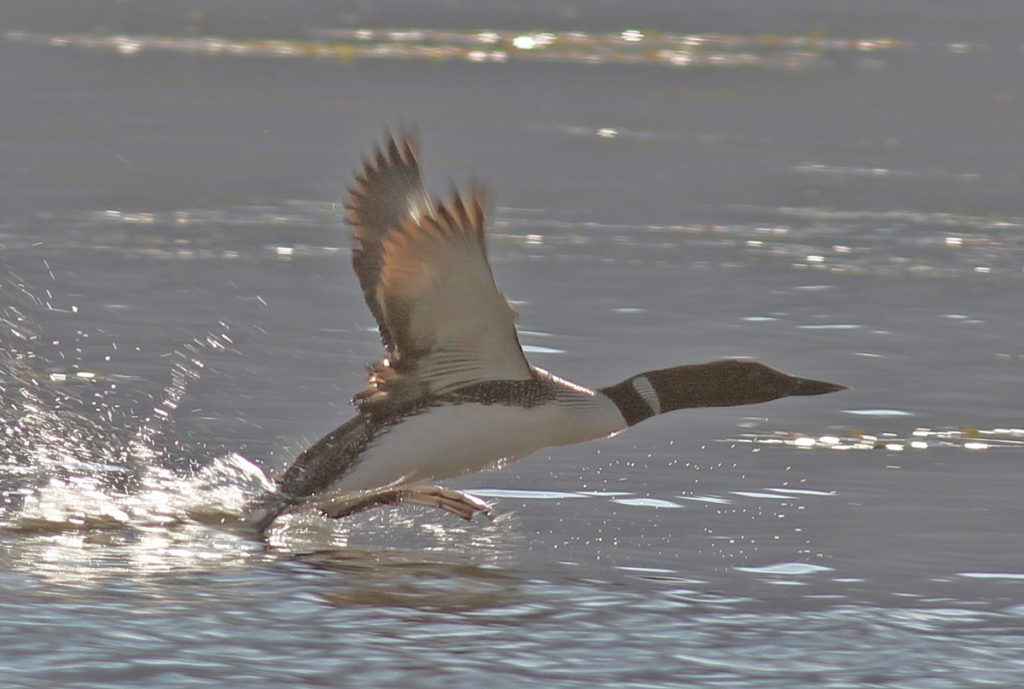This past summer had, as each season does, many exciting birds reported. A male Ring-necked Duck was photographed at the Bishop Wastewater Treatment Plant on 11 June (C&RH). A female Lesser Scaup was found at Klondike Lake 28 July (original observers failed to submit any documentation) and later in the day photographed (TSH). These two species are fairly common in winter but typically absent in summer. A Common Loon is a regular spring and fall migrant but is casual (seen less than seven years in a decade) in summer. One in basic plumage was photographed at Tinemaha Reservoir 25 May (KH-L), summered, and was joined by a second bird in alternate plumage in July (multiple observers). Another casual visitor was a Common Gallinule photographed at Klondike Lake 17 June (TSH) that remained through 30 June (C&RH, J&DP) and six rare Black Swifts were west of Big Pine 28 June (J&DP). Mountain Chickadees and Brown Creepers are common in our mountains all year and some winters they descend to the valley floor but both species were reported in Bishop this summer when casual (C&RH, J&DP) and an American Pipit, for which there are very few breeding records, was seen feeding young near Cirque Lake, west of Lone Pine 14 June (SLS). The amazing Curve-billed Thrasher continued being photographed at Starlite through June (J&DP, JTZ) where it set up residency two years ago (R&KS). A casual Summer Tanager was photographed at Glacier Lodge 29 July (TSH) as was a rare Indigo Bunting at Division Creek 20 June (J&DP) and finally, a rare male and female Lawrence’s Goldfinch were at Starlite 25 June (J&DP). While there were other good avian finds, these were the highlight species and all were supported with images, audio files, and/or documentation that validated the accuracy of the identifications.
Each season, county coordinators for the journal North American Birds prepare a seasonal report for the editors of their region. County coordinators could not submit a report without the help of birders who turned their rumors into records by supplying evidence, such as images, sound recordings, or written descriptions, of their claims. This network of coordinators extends throughout Canada, the U.S., Mexico, and Central America with the purpose of informing the public of significant ornithological occurrences during each season. If you find a species that is rare or casual, for the date, location, elevation, number, etc., it should be reported. We urge you to consider sharing your observations with others and submitting your evidence to the county coordinators for publishing consideration in the North American Birds journal. If the sighting occurred in Mono County contact Kristie Nelson (storm_petrel@hotmail.com) or Tom & Jo (tjheindel@gmail.com)if in Inyo County.The Birding Calendar looks somewhat different than the calendar used over most of the world! The “birding” seasons are graphed here:

County coordinators have to get their reports to the regional editors by the middle of the month following the end of the season. This is a tight turnaround, especially in spring and fall, so they appreciate receiving your sightings by the tenth of the month. Please do not assume that your Facebook or eBird entries will suffice…they must be personally submitted to the county coordinators. (Email or Eastern Sierra Birds Google Group posting is okay. Because we receive the Eastern Sierra Birds submissions as they are posted, we don’t need to be copied on them. If they include images and/or descriptions of the species, they are downloaded and added to the NAB report and Inyo County Avian Archives.)
Some species require just a few sentences but others, because of their rarity or their difficulty to identify correctly, require much more and the maxim, “A picture is worth a thousand words,” was created for birders! (even blurry photos that show field marks help a lot!) Formats for writing bird descriptions are available online or request one from us if you’d like some guidance. Read more about this, plus download a list of which species require further documentation, on our North American Birds webpage.
Have a great Fall season and we look forward to collating all the evidence the Eastern Sierra birders gather for archiving in perpetuity!
Contributors for summer report: Jim and Debby Parker, Chris & Rosie Howard, Tom Heindel, Kelli Heindel-Levinson, Rick & Karen Scott, Susan Steele, and Jerry Zatorski–our gratitude to all!
We solicit your help in making each seasonal report more complete so consider submitting reports of interesting and unusual sightings of rare or very rare species, along with documentation and/or images to tjheindel@gmail.com. Information on which birds need extra documentation, and how and when to submit, is on our Inyo Bird Checklist page.
Tom and Jo Heindel have contributed a vast amount of their knowledge to the Wave Newsletter over the years (from 1993 on!). Those articles have been archived for reference, here: Heindel’sarticles and season highlights.
Tags: duck, wren



